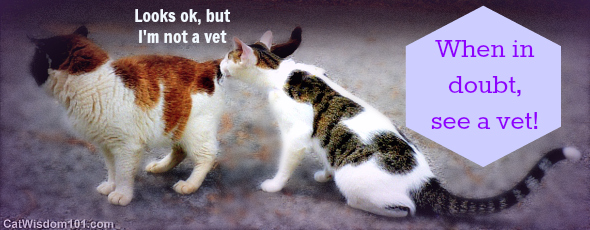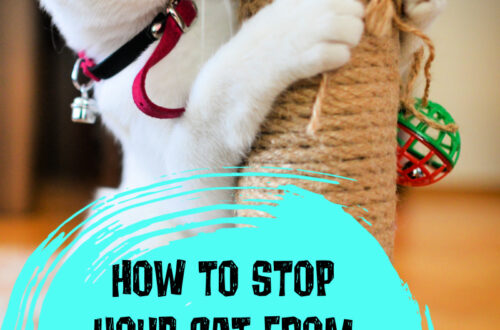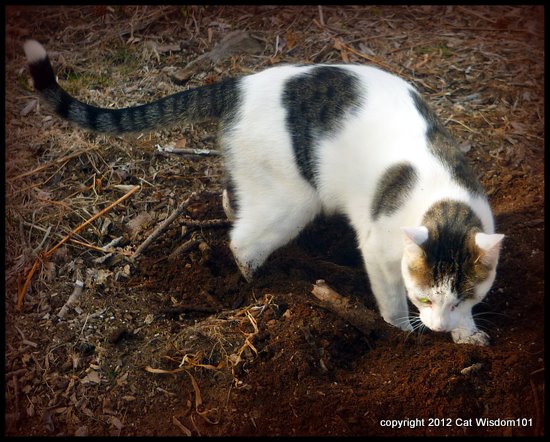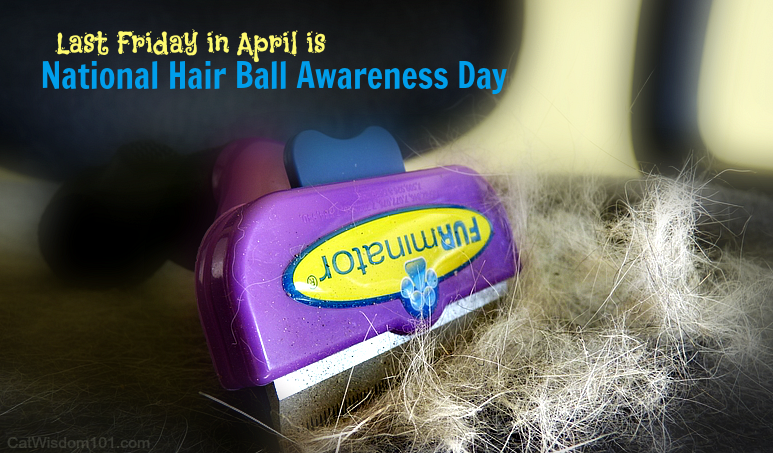Vet 101: Report From The Cat DocTrenches

When we take our cats to the vet we’re usually focused on our own pet. If your cat is ill, all we want to know is will she get better. Your cat might one of a dozen pets a vet might see that day. I’ve often wondered how do vets deal with so many different, non-speaking patients all day, so asked Dr. Letrisa Miller, a veterinarian who sees only feline patients what’s it like. This is her report from the cat doc trenches. You’ll want to give your vet a big hug after reading this!
Hello from the trenches (as many veterinarians call life on the floor of a clinic or hospital)! This week I want to share a recent day of practice because few people get the chance to shadow a veterinarian and not many know what a day is like in clinical practice. Most people’s experience of the veterinary office goes no further than what they can observe when they bring their cat in for its semiannual appointment. What they see then is just the tip of the proverbial iceberg.
My day at work starts at 8:30 AM, a relatively late start in this business. The first item to take care of is hospitalized patients and my clinic cats, Monster and Bella. Monster always ends up being first because he is a diabetic and needs insulin every 12 hours, not to mention he is very (!) noisy until he gets breakfast. I unlock the door, disarm the security system, let Bella out of her nighttime home (my office), put my coffee on the counter, and step over to the fridge to draw up Monster’s insulin and medication for bile duct narrowing.
I go to the hospital kennels where Monster spends his nights and open his kennel. Not content to wait for me to open the kennel door all the way, he immediately pushes his way out and jumps down to the floor, then yells at me for not having his breakfast ready fast enough. I get out a can of his high-protein, low-carb diet, then I give him his injection and oral medication. Meanwhile, Bella is staring woefully at me from the hospital doorway. “Sorry, Bella. I have to check on patients before you get your breakfast.”
In the hospital I have a cat who had stopped eating while his human was out of town. Yesterday’s lab results showed that he has kidney failure, and I am currently trying to figure out if it is acute kidney failure or end-stage chronic kidney failure. His IV checks out fine, and he has gotten the right amount of fluids overnight. If his lab results improve to close to a normal number after 2 to 3 days on diuresis (IV fluids at a high rate), then he has a chance of surviving. He looks brighter today but still has not eaten anything. I’m not surprised that he hasn’t eaten given how severe his dehydration was yesterday and how severe the toxin buildup was in his blood from the kidney failure. Cats that have kidney failure have very poor appetites. I weigh him and give him his medications while I give him an exam. I am very worried about him.
I look in on the cat that came in yesterday for a neuter but just wouldn’t stop bleeding from his incision site. He was a little older than usual for a neuter but not old enough that I expected post-surgical bleeding. He is hiding behind his “security box,” which lets him have some privacy in the hospital. The towel he was given yesterday evening has several moderate-size spots of blood on it. What is going on? Does he have a bleeding disorder? Is he managing to chew on the surgical site while we aren’t watching? Oi! I will need to call his owners to get permission to check for a clotting disorder.
I feed Bella her prescription diet for feline lower urinary tract disease and pet her while I download yesterday’s lab results from the outside lab. I have results for a cat that came to see me yesterday with a history of anemia and chronic diarrhea that a previous veterinarian had diagnosed as feline infectious anemia (Mycoplasma infection). His results show not just severe anemia but that all types of blood cells are low. The results also indicate his bone marrow is not responding. I am still waiting for the test results for gastrointestinal disease. I mentally review the causes of pancytopenia (low blood cells of all types) in adult cats: bone marrow suppression, cancer. Could it be something even more rare than those? I’ll have to think about this later because I now have a client and sick patient waiting for me in an exam room.
On my way to the appointment, I ask the receptionist to call the owner of the kidney failure patient to give him my update and to call the bleeding cat’s people can for permission to do a blood clotting test.
My first appointment is a 6-month-old kitten who is vomiting. Her owner found chewed ribbon after the kitten started vomiting the night before. She has vomited everything she has eaten since yesterday evening and the client found some ribbon in her vomitus. I do a physical exam and find a bright and alert kitten with a normal temperature; however, she is not as active as she should be. Her abdomen is not painful, and she is not dehydrated or distressed. I look under her tongue but don’t find any ribbon caught there. I spend some time talking with the client about options.
First we have to try to figure out if the swallowed ribbon is still inside. The easiest way to figure that out is to use an endoscope, but I don’t have one and the client doesn’t want to take the kitten to a referral hospital that does. The ribbon is very fine, a type that won’t show up on X-ray images, so we decide to hospitalize the kitten and watch for development of fever or abdominal pain. Either of these is a signal that she has to go to surgery. The other signal to take her to surgery is if she can’t keep anything at all in her stomach.
I talk through the financial side of the treatment with the client, and they are very concerned about the cost of hospitalization and potential surgery but are even more concerned with the cost of diagnostic tests. The client agrees to treat, and I take the kitten downstairs and place an IV catheter, get her started on IV fluids to prevent dehydration, and give her a dose of gastrointestinal lubricant (hairball remedy) while my next appointment is checked in.
As I go back upstairs to see my next patient, the receptionist flags me down to tell me that a patient I saw last week is unable to have a bowel movement. Since this is an urgent condition, I ask for the cat to be brought in today.
I step into the next appointment after being briefed by my assistant. This patient is one with severe dental inflammation and crusty eyes and nose. I started him on doxycycline (an antibiotic that has strong anti-inflammatory action) 10 days ago. As I examine him I note that his eyes are no longer red and crusty and there are no crusts in his nose, but the dental disease still looks pretty bad. He needs to be scheduled for a dental cleaning and to continue on the antibiotic. As I leave the room looking forward to lunch, I ask the receptionist to schedule a dental cleaning for this patient for some time in the next 10 days. At this point, the client with the constipated cat walks in. I didn’t need lunch anyway, right?
I talk with the client for about 10 minutes and examine the cat. He has a large amount of very hard stool in his colon and will need an enema. Because I think he may need more than just one enema to soften and pass the stool, I ask to keep him for the rest of the day. I take him downstairs, put him in a kennel and gather the supplies for the enema.
As I finish up and get the patient comfortable in his kennel, the intercom buzzes to let me know that my next appointment is here. This one is a kitten who has been being aggressive and biting at home. My job here is to figure out if this is a behavior problem or a medical problem. I start by talking with the client for about 20 minutes about the kitten’s home life and history while simultaneously watching the kitten in the exam room. I note that the kitten has a limp and seems a little shy. On physical exam, I find that the kitten’s left hip is at least 1 cm higher than the right and that the kitten is very reluctant to be touched in her lower back and hip areas. She tries to bite when I run my fingers down her lumbar back muscles. The client says that no one who had looked at the kitten in the past had noted these issues. She also noted that all of the kitten’s littermates had been killed when they were run over by a car. One previous veterinarian had mentioned that the kitten would need surgery to repair a hernia.
I recommend radiographs (X-rays) to see what is going on with the pelvis or hips. The client agrees and I take the kitten downstairs to get ready for the X-rays. As we start to take X-rays, we find that the footswitch on the new X-ray machine is not working. What are we going to do now?
After a bit of thought, my assistant asks if the dental X-ray could be used. I think about it for a minute and come up with a plan. We rig the machine up on a tripod and snap a couple of rads. Voila! The kitten has a broken pelvis and dislocated sacroiliac joint. As I look a second time at the radiographs, I note that a large loop of bowel is not in the abdominal cavity and is instead just below the skin on the belly. This kitten has a HUGE hernia, and that is probably the source of the biting attacks. As the intestine tries to contract and move food through, it is fighting against scar tissue and that causes big bursts of pain. The solution to the problem will be surgery to put the kitten’s abdomen back together in a more normal way. It is amazing that the kitten survived the trauma it had previously. I talk to the client about our findings and send the kitten home with pain medication pending surgery.
Right. Off to the next appointment. Wellness care for a new client and patient. This sort of office call takes about an hour in my practice because we ask a lot of questions and go through findings in every body system with the client. This kitty is healthy other than needing to have teeth cleaned. I love seeing healthy kitties with A’s on their report cards!
My next appointment is a kitty I am seeing to recheck kidney insufficiency. She is doing OK but is still not quite right at home. I let the get comfortable in the exam room while I talk with the client about what we can for cats with early kidney disease to prevent the disease from getting any worse. One thing that is very important is to check for high blood pressure because cats with kidney disease are at high risk for this. The patient is calm now, so I pull out my Doppler blood pressure monitor and wrap the cuff around the base of the patient’s tail. I take her blood pressure 6 times and find that all of the values are near 200 mmHg! That’s nearly double what is normal and is well above acceptable. I prescribe amlodipine for high blood pressure and send her home.
As the client from the last appointment is leaving, she mentions that her other cat, which goes outside, has been drooling since yesterday. Is this normal?
I swallow hard and say no as I look at the clock that now says 5:30 pm (theoretically we close at 5:00). I am concerned that the drooling cat could have something seriously wrong, and because I’ll be here for at least another hour anyway, I ask if she would like to bring it in for a quick look. Her boyfriend will do so ASAP.
I go back downstairs to check on the hospitalized patients. The constipated cat has still not had a bowel movement, so I give him another enema then call his owner to get permission to keep him overnight. The ribbon-eating kitten is not doing as well as I would like. She doesn’t have a fever, but has now started vomiting. The cat with kidney failure is still about the same. I draw blood from him to check his electrolytes and other lab values. His electrolytes are much better than yesterday, but his kidney values don’t look good. I call his owner with an update. The bleeding neuter is still seeping blood. The client agreed to the lab work to check for a bleeding disorder, so I draw blood and fill out the paperwork for the outside lab.
I hear a knock on the door and find that the drooling kitty has arrived. She looks alert and does not have any abnormalities on physical except she is drooling slightly and has a slight fever. I question her co-owner and find that she likes to play with frogs. I suspect she has been playing with a toxic toad. Drooling is a classic symptom of toad envenomation. She is eating and drinking and otherwise behaving normally at home, so I do not see a need to hospitalize her. I send her home with instructions to keep her indoors for 12 hours and bring her back in the morning if she is still drooling.
I give Monster his evening insulin, pill, and food and go back to check on the kitten. She is quieter than last time is checked her and I call the client to let her know that I want to take her to surgery. The client agrees and we start prepping her. We get her into the O.R. She is stable under anesthesia and has good vital signs. I begin to search for ribbon… None found in her stomach after a thorough search. I “run” the bowel looking for the problem and finally see a line of blue (The color of the ribbon she ate.). There is no sign of any perforation in the intestine along the length of the ribbon. I make an incision in the intestine over it and pull, out comes the ribbon. I suture up the hole I have made and check it for leaks. No leaks and no more ribbon. She is going to feel so much better! I close her abdomen and we wake her up.
While she is recovering, I call the client with the good news and then I check for messages and new lab results. I find that the long-awaited results from a bile culture sent out a week ago has come in. I can now choose an appropriate antibiotic to put the cat on! But I will have to wait until tomorrow to call the client because it’s well past the hour when a veterinarian’s call would be welcomed.
Oh wait! I still have to figure out what to do about the patient whose lab results came in this morning. I decide I can research that at home. I get to my car and look at my watch. It’s 10:45 pm. The sign in the office window might say 9 to 5, but don’t let that fool you. It’s a rare day that I work 9 to 5.
Have a great day!
Dr. Letrisa Miller has a feline exclusive practice Connecticut Feline Medicine & Surgery.




22 Comments
Texas, a cat in New York
That was a very interesting post! Good human deserves purrs =^.^=
Sweet Purrfections
Wonderful post! Mom Paula also has a new appreciation for vets and wishes she could find a vet like Dr. Miller near us. Mom Paula hasn’t been totally happy with any of the vets she’s been to since moving back to Columbia.
Cat-from-Sydney
I love you Dr Miller! Will you marry me……ooops….will you be my vet? har har har *seductive laughs*
Brad the most handsome
Skeeter and Izzy
I worked in an animal clinic and have the utmost appreciation for the vets,techs, and assistants that do the jobs. The day Dr. Miller described didn’t even include any extreme emergencies like being hit by a car etc. It takes special people to do special jobs with special care. Thank you to all those that do these jobs!!!! Luvs to animal docs and their help everywhere Skeeter and Izzy >^@@^<
Mary Matthews
What an awesome vet! Thanks for posting a day in Dr. Miller’s life. It’s also a great reminder to appreciate every healthy day we have….cats and humans.
da tabbies o trout towne
headbonks….ouch…. ta Dr Miller Odin; N de blessings oh St Francis two her….sadly in this day N age… findin one with az much compassion N concern seems rare….leest wear we live….
CATachresis
Would Dr Miller consider a move to the UK? Kudos for the care she gives 🙂
Brian
Oh my goodness, that was quite a good perspective on that scene!
Penelope
We has a great vet! When our hairy slobbery sister Sam, got sick last summer (and finally went over the bridge) she slept at the office so she could check on Sam in the middle of the night. Me even likes her and me even let her takes my temperature (that has never ever happened before). Vets work very hard! Kisses and Kudos to Dr. Letrisa Miller and vets like her!
Nellie
Deb n Cats
I have a vet like Dr. Miller. When you find them, they are worth their weight in gold. /Salute to Dr. Miller and her staff.
Connie Marie
I’m impressed with Dr. Miller ! The caring and dedication to her patients is amazing. So thorough with the exam, questions and follow thru.
Dr. Miller you are truly the Best!
Katie Isabella
This is a great informative post and I thank you for that.
Mom and I are very glad of my Dr. and so was the Admiral. He also has continuing education at the University when it’s offered and reads a lot too so as to better serve his patients. They go thru a lot.
Tamago
Wow what a day and it must be like this every day. She is such a wonderful, dedicated vet. I hope she can get enough time for lunch though!
Jessica Bronder
What a great post! It’s amazing what vets and their techs do. It’s so easy to forget that they do have a ton of other things going on when one of our furry children is sick and we are in a panic to get them better. Thanks!
Glogirly and Katie
Wow. This really puts it into perspective. My respect and gratitude for our vets has just skyrocketed. What a wonderfully dedicated and compassionate professional she is. …and I’m certain she is not alone.
Katie may not be a fan of her Vet, but I sure am. Katie was that ribbon kitty. Were it not for the quick thinking expertise of the Vet Tech who gave me advice on the phone from home one Sunday evening and the Vet who performed her emergency surgery the same night…well, you certainly would not be visiting a blog called Glogirly-Tails Of A Cat And Her Girl.
xo, Glogirly
Random Felines
That was quite insightful…..thanks for the “inside” look 🙂
Zee and Zoey - Deb Barnes
Yikes… that is quite intense and very informative! I had no idea how complicated an average day could be and really commend Dr. Miller for her dedication and passion.
naomi
Thank you for being the kind of animal doctor who is devoted not just to your patiens but to their human parents as well.
RumpyDog!
I had a good vet like that once. When I first started seeing him, his children were small, his eyes were bright and he was very dedicated. The last time I saw him, his eyes were tired, he was tired, and his kids were grown.
I would tell this vet that while I appreciate her dedication, I hope she finds a happy balance, or she will end up being one of those vets that I bet she swore she would never be.
d'Artagnan Rumblepurr
Please thank this wonderful vet for all she does.
Sparkle
My human says she wishes Dr. Miller was MY vet – we (neither her nor I) have not been happy with ANY of the vets we’ve seen here in Los Angeles.
Debby
Wow, I have a whole new appreciation for vets!